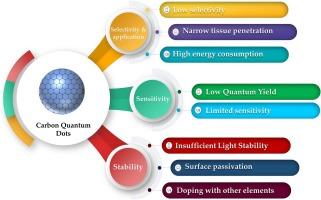在化学分析中应用发光碳点的技巧和窍门:最新进展、障碍和未来展望
IF 4.9
2区 化学
Q1 CHEMISTRY, ANALYTICAL
引用次数: 0
摘要
碳点(CD)因其独特的属性和在多个领域的可能用途而得到广泛认可,在过去几年中引起了越来越多的关注。碳点的直径通常小于 10 纳米,由结晶或无定形的碳原子组成。CD 的合成有多种方法,包括自下而上和自上而下的方法。自下而上的方法包括水热法、微波法和热解合成法,而自上而下的方法包括电化学法和激光烧蚀法。这些方法产生的光盘具有不同的尺寸、表面官能团和光学特性。透射电子显微镜 (TEM)、X 射线衍射 (XRD)、傅立叶变换红外光谱 (FTIR) 和 X 射线光电子能谱 (XPS) 等技术经常被用来研究光盘的形态、结构和化学成分。此外,还回顾了与光盘有关的主要问题和障碍,以及为推进相关研究领域所做的努力。光盘在生物成像、药物输送、光催化和传感器等领域具有潜在用途。它们具有优异的光学特性,与生物体相容性好,对健康的危害极小,因此是生物和环境应用的理想候选材料。总之,CD 具有广泛的潜在用途,被认为是一种多用途纳米粒子。还需要进行更多的研究,以考察其特性并改进其生产工艺,以满足特定应用的需要。本文章由计算机程序翻译,如有差异,请以英文原文为准。

Tips and Tricks for Applying luminescent carbon dots in chemical Analysis: Recent Advancements, Obstacles, and future Outlook
Carbon dots (CDs) have become widely recognized for their distinct attributes and possible uses in a variety of areas, leading to increased interest over the last few years. CDs are usually smaller than 10 nm in diameter and are composed of carbon atoms organized in either a crystalline or amorphous form. The synthesis of CDs can be achieved through various methods, including bottom-up and top-down approaches. The bottom-up approach includes hydrothermal, microwave, and pyrolysis synthesis, while the top-down approach includes electrochemical and laser ablation methods. These methods result in CDs with different sizes, surface functional groups, and optical properties. Techniques such as transmission electron microscopy (TEM), X-ray diffraction (XRD), Fourier-transform infrared spectroscopy (FTIR), and X-ray photoelectron spectroscopy (XPS) are frequently employed to examine the morphology, structure, and chemical composition of CDs. Additionally, the primary problems and obstacles related to CDs are reviewed, along with efforts to advance the related research fields. CDs have demonstrated potential uses in areas including bioimaging, drug delivery, photocatalysis, and sensors. Their exceptional optical characteristics, compatibility with living organisms, and minimal harmful effects on health make them perfect candidates for utilization in biological and environmental applications. In summary, CDs have a broad scope of potential uses and are considered a versatile category of nanoparticles. More investigation is required to examine their characteristics and improve their production processes for particular applications.
求助全文
通过发布文献求助,成功后即可免费获取论文全文。
去求助
来源期刊

Microchemical Journal
化学-分析化学
CiteScore
8.70
自引率
8.30%
发文量
1131
审稿时长
1.9 months
期刊介绍:
The Microchemical Journal is a peer reviewed journal devoted to all aspects and phases of analytical chemistry and chemical analysis. The Microchemical Journal publishes articles which are at the forefront of modern analytical chemistry and cover innovations in the techniques to the finest possible limits. This includes fundamental aspects, instrumentation, new developments, innovative and novel methods and applications including environmental and clinical field.
Traditional classical analytical methods such as spectrophotometry and titrimetry as well as established instrumentation methods such as flame and graphite furnace atomic absorption spectrometry, gas chromatography, and modified glassy or carbon electrode electrochemical methods will be considered, provided they show significant improvements and novelty compared to the established methods.
 求助内容:
求助内容: 应助结果提醒方式:
应助结果提醒方式:


